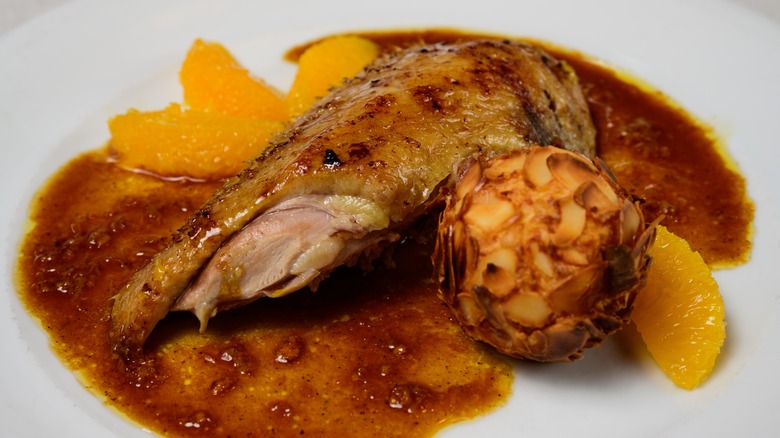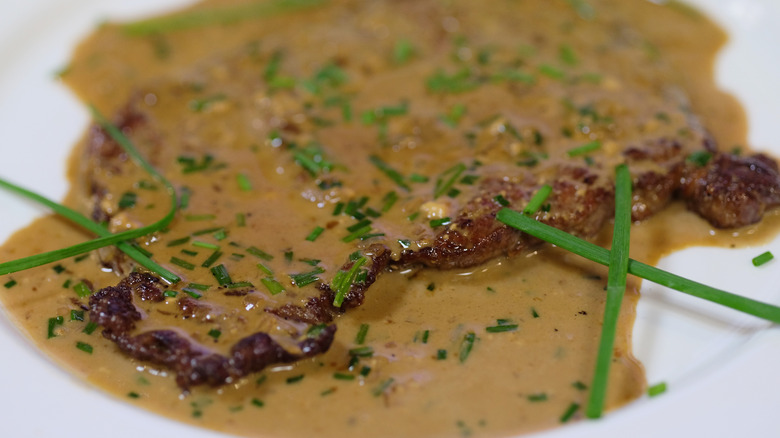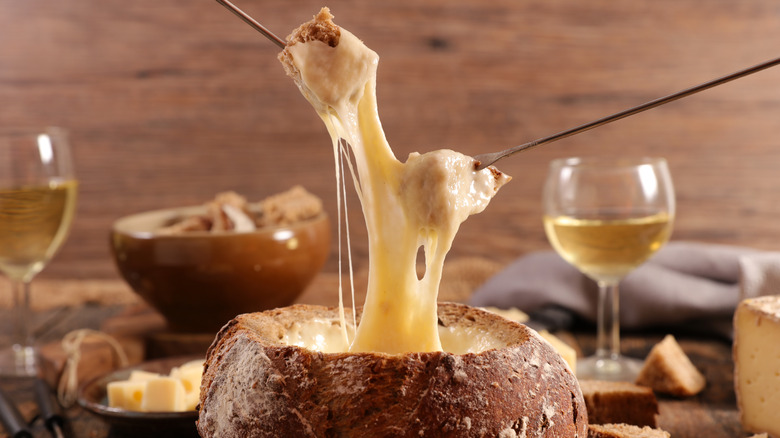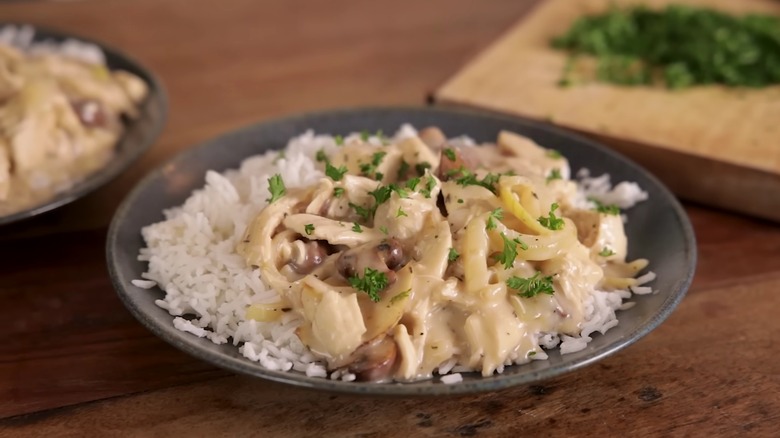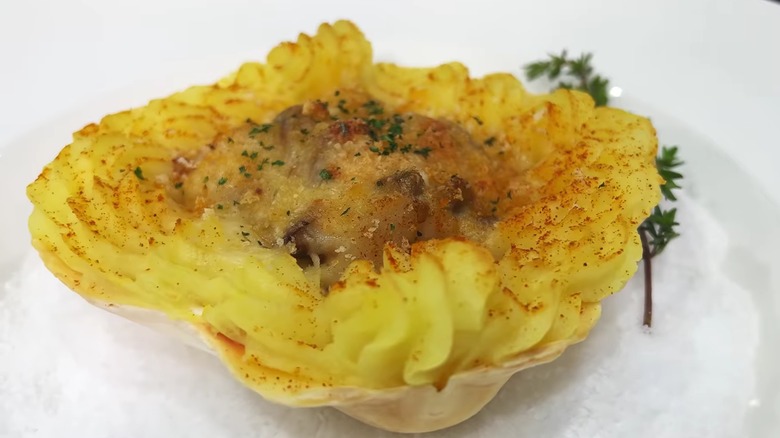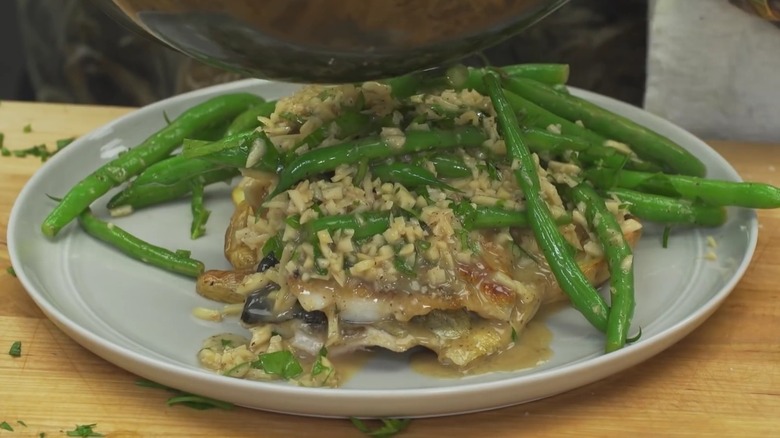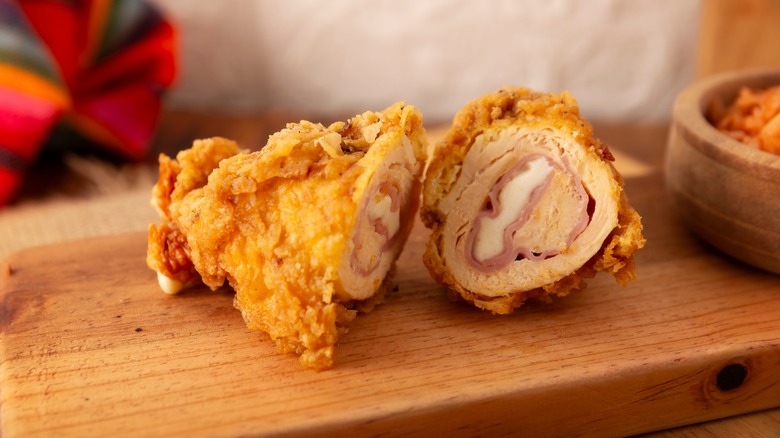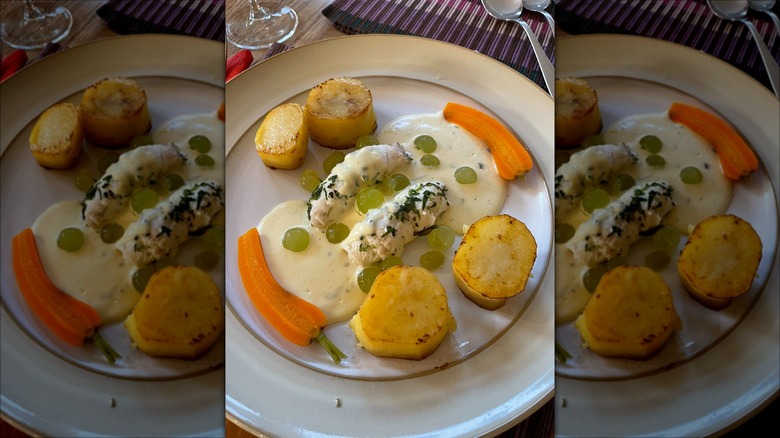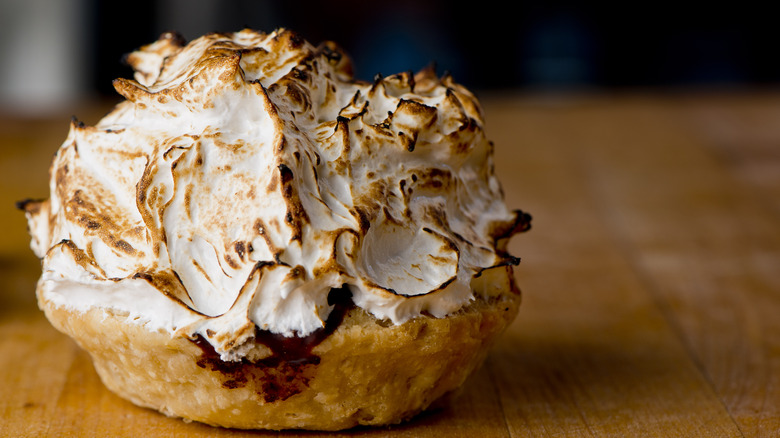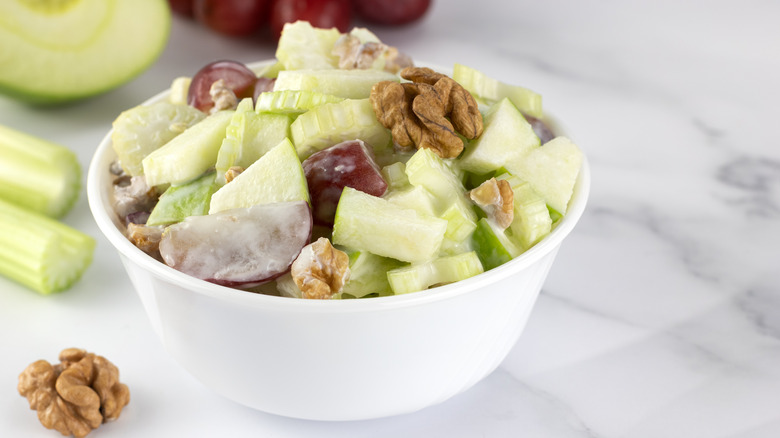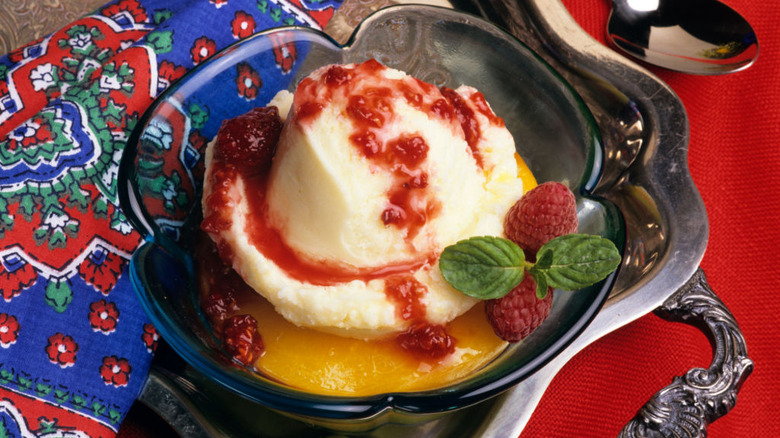12 Old-School Restaurant Dishes We Wish Would Make A Comeback
Ask anyone who works in restaurants and they'll tell you that food trends are largely unpredictable. At this time of writing, fried chicken and Caesar salads are decidedly in while avocado toast and ramen burgers are old news. As the meteoric rise of some of these dishes attest, the faddish nature of food has been supercharged by social media. That being said, dishes have been coming in and out of fashion for as long as restaurants have been operating — as the following 12 old-school dishes prove.
There is hope that some of these excellent, albeit dated, dishes will return to the spotlight as restaurants across the world revert to classics in order to appease customers. In an interview with Condé Nast Traveller, Simon Attridge, Culinary Director at Claridge's in London, said, "It's been a tough couple of years. So nostalgia is coming back because it drives happy memories of excitement, of a more relaxed, seemingly problem-free time." While nostalgia won't be enough to bring all the dishes mentioned in this article back to prominence, there are more than a few that, with a subtle makeover, would not look out of place on modern menus.
1. Duck à l'orange
There are several theories as to how and where duck à l'orange was invented. All agree that the base ideology of the dish — pairing roasted meat with cooked fruit — comes from the Middle East. Most, but not all, also concede that the dish was brought to France by the Italian Catherine de Medici during the 1530s. In the 1960s and 1970s, the dish reached the height of its popularity. At this time, it was routinely served in restaurants across the United States and by many home cooks, often under the guidance of Julia Child.
Due to difficulties in procuring bittersweet Seville oranges at this time, many restaurants made do with other orange varieties. The result was an overwhelmingly sweet sauce that dominated the dish. This super-sweet flavor profile gave duck à l'orange a bad reputation and ultimately contributed to its steady demise. Today, very few restaurants serve this classic; most of the few that do are traditional, old-school haunts located in France itself.
Aside from ensuring the correct oranges are used, the places that successfully serve duck à l'orange make sure to render the duck meat. This results in crisp skin and meat that isn't too greasy. When this well prepared duck is paired with the tart sauce, the result is an enticing combination that still has the potential to impress those eating at chic restaurants today.
2. Steak Diane
Steak Diane is a quintessential example of indulgent midcentury cooking. The dish involves pounding a tender steak, often sirloin or filet, to a quarter of an inch thickness before cooking it for no longer than two minutes. This rare meat is then doused in sauce à la Diane, an intensely flavored pan sauce made from brandy, cream, truffles, and black pepper.
The dish achieved its mass popularity thanks to being served at the Drake Hotel in Manhattan under the watchful eye of maître d'hôtel Beniamino Schiavon. But despite it being one of the most conspicuous dishes of the 1960s and '70s, few restaurants serve steak Diane today. As with many dishes of its time, steak Diane is now deemed too rich and decadent for modern customers, many of whom prefer lighter, sharper meals. However, it is not inconceivable that some classic steakhouses, such as The Old Homestead Steakhouse in New York City or St. Elmo Steakhouse in Indianapolis, might reintroduce this old-school dish to their illustrious menus at some point in the future.
3. Fondue
Fondue has been eaten in Switzerland since the 17th century and was declared the country's national dish in the 1930s. After appearing at the 1964 New York World's Fair, the dish went global. By the 1970s, most people across the United States knew and loved fondue.
While it's often said that the best fondue is made at home, many American restaurants began serving the dish during the 1970s. These included Melting Pot, a fondue chain which opened its first location in 1975. While many Melting Pot locations remain open today, the number of other restaurants that serve fondue has fallen dramatically. This is a shame, as fondue is both an incredibly delicious dish and one that is unique in its ability to facilitate conversation and interaction between customers.
The success of a few independent fondue restaurants, including Geja's Cafe in Chicago and The Little Dipper in Wilmington, prove that selling tasty fondue made from a variety of cheeses can be the basis of a flourishing business. However, it seems unlikely that many other restaurateurs will take the plunge while fondue is still viewed as a somewhat novelty dinner.
4. Vichyssoise
While soup continues to play an integral role in the menus of many American restaurants, cold soups like vichyssoise have generally been left behind. There are many suggestions as to why this is. Some people, including Kay Rentschler of The New York Times, posit that this is because cold soup is a difficult concept for many chowder-loving Americans to wrap their heads around, especially when that cold soup is not gazpacho. Interestingly, though, this has not always been the case.
Vichyssoise, a cold soup made with puréed leeks, onions, potatoes, cream, and stock, was invented by Louis Diat who was chef de cuisine at the Ritz-Carlton in New York for over 40 years. Diat invented the soup, a variation on something his mother served him when he was a child, in order to placate guests who were staying in New York during sweltering summers. Then, as now, the dish proved incredibly effective thanks to its cold temperature and slightly tart flavor.
Diat's soup became incredibly popular during the mid-20th century when other culinary luminaries, such as Julia Child and Simone Beck, printed vichyssoise recipes of their own. However, the soup has since gone out of fashion and is now only rarely seen on the nation's menus. We sincerely hope it finds its way back to notoriety, preferably before the next summer arrives.
5. Chicken à la king
It is thought that chicken à la king was first served at the Brighton Beach Hotel, just outside of Manhattan, sometime during the early 1900s by chef George Greenwald. The dish, which features chunks of chicken served among vegetables and a boozy cream sauce, was a common feature of restaurant menus in the early 1900s and later on in the century when New York Times food writer Craig Claiborne re-popularized the dish. But it was firmly out of favor by the late 1980s, when food writer Marian Burros described it in a New York Times article as "that unspeakable mixture of flour-laden sauce with bits of canned mushrooms, canned pimento and overcooked chicken." Since this time, the dish has never regained its old standing.
While it's natural for old-school dishes to steadily fall in popularity, it is surprising that chicken à la king has been so routinely ignored by 21st century chefs. Thanks to the creamy sauce, chicken à la king sates the public's enduring appetite for rich, comforting foods. The dish also makes use of one of the United States' most beloved ingredients: chicken. Despite these points, it looks unlikely that we'll ever see chicken à la king on restaurant menus again. For that, Burros will be eternally thankful.
6. Coquilles St. Jacques
Coquilles St. Jacques is the French term used to describe great scallops (Pecten maximus). In the United States, however, the term refers to a once-popular scallop dish usually served as an appetizer. This dish sees scallops poached before being covered in breadcrumbs, a butter and wine sauce, and grilled, making it reminiscent of another 20th century classic, oysters Rockefeller. Unlike that dish, however, coquilles St. Jacques has fallen out of fashion and is now rarely served in contemporary restaurants.
There seems to be no singular reason as to why this is. Unlike several other dishes mentioned in this article, the combination of flavors and textures still appeals to modern diners, as the enduring popularity of oysters Rockefeller attests to. There are suggestions that the dish is too expensive to make, or that quality scallops are too difficult to source. A further opinion holds that people's view of the dish has been ruined thanks to poor iterations that feature a too-heavy sauce and the addition of mashed potato. However, these seem more like weak excuses instead of actual reasons. At least this gives us hope that some budding chefs will give this dish the second chance it so richly deserves.
7. Trout amandine
Often viewed as a take on the classic sole meunière, trout amandine is a dish that gained popularity in New Orleans during the 1960s. The trout is dredged in flour before being sautéed. Then, butter is browned. Almonds are added to the butter for a few minutes, then the resulting mixture is poured over the fish. This simple preparation belies an impressive amount of flavor, characteristics that saw the dish become a firm fixture of restaurants across the nation.
Despite being a favorite of chefs, trout amandine is rarely seen in modern restaurants outside of New Orleans. One theory is that the dish did not survive the low-fat craze of the 1980s, thanks to its butter-rich sauce. Now, with nutritional advice regarding fat somewhat different to what it was over 40 years ago, we hope trout amandine can make a well-deserved comeback and bring its unique flavor back to the nation's menus.
8. Chicken cordon bleu
Chicken cordon bleu made it big in mid-20th century America. This is a dish made from chicken breasts which are stuffed with sliced ham and cheese before being breaded, fried, and baked. The resulting dish is incredibly comforting and indulgent in much the same way that both chicken Kiev and schnitzel are.
Although this style of breaded, stuffed protein might seem out of date now, in the 1960s and 1970s it was thought to be highly sophisticated. This likely had something to do with the name "cordon bleu" which became synonymous with culinary excellence. Yet in recent years, the dish has fallen from favor, with prestigious restaurants removing it from their menus. Some quick-service restaurants, such as Arby's, have even failed to popularize cheap versions of the dish; the company was recently forced to remove the item from locations due to a lack of sales. As such, it seems unlikely that chicken cordon bleu will return to any part of America's dining scene in the near future.
9. Sole Véronique
Sole Véronique was invented by legendary chef Auguste Escoffier, most likely in 1903 when he was working in London's Ritz Carlton hotel. The dish, which was created to celebrate Véronique, a popular opera that was playing at the time, is made by pairing fresh sole with a cream sauce, tarragon, and peeled green grapes.
Given this ingredient list, it might not be hard to discern why the dish has fallen out of favor; it is undeniably old-school. Yet sole Véronique is not any less delicious because of that. The sauce is luxurious, and the fish incredibly tender. Even the grapes and tarragon add extra dimensions to the dish without unbalancing it.
Aware of this fact, some modern chefs have attempted to update this classic. These include Barry Tonkinson, vice president of culinary operations at the Institute of Culinary Education. In his recipe, the sole is cooked in a sous vide, the tarragon is delivered via flavored oil, and the grapes are turned into a gel. Such imaginative recreation hints at the possibility of sole Véronique becoming a popular feature on restaurant menus again, over 100 years after its invention.
10. Baked Alaska
Baked Alaska is a dessert made of ice cream and sponge cake encased in a torched meringue. The beauty of the dish is that the meringue shell is hot while the ice cream inside remains cold. Meringue's insulating abilities were discovered by Count Rumford, an American scientist, during the first half of the 19th century. Several dishes utilizing this new knowledge were made during the 19th century; baked Alaska as we know it was introduced to the public by chef Charles Ranhofer who was working at the iconic American restaurant Delmonico's.
Due to a lack of advanced technology, baked Alaska was incredibly difficult to make at this time. This ensured that, during the late 19th and early 20th century, it was seen as an immensely sophisticated and exclusive restaurant dessert; a serving of Delmonico's baked Alaska would set diners back around $40 in today's money. Technology has since advanced and customers are no longer impressed by a combination of hot meringue and cold ice cream. This is one of the reasons why the dish, while still served in some restaurants including Delmonico's, is far less popular than it once was. It looks unlikely that the dessert will ever return to its previous fad status.
11. Waldorf salad
Waldorf salad was invented by Oscar Tschirky, maitre d' of the Waldorf Hotel, for an 1893 charity ball. Initially, the salad was made of three ingredients: celery, apples and mayonnaise. Walnuts and grapes were added in the ensuing decades, resulting in the dish we recognize today.
Thanks in no small part to the hotel's prestigious reputation, Waldorf salad has always enjoyed a glamorous reputation despite its simple nature. While this reputation was enough to ensure the salad's early popularity, in recent decades it has dropped off the radar. A few restaurants and hotels continue to serve Waldorf salad, the Waldorf-Astoria among them. During his time as culinary director at the hotel, David Garcelon estimated that it served 20,000 portions of the salad per year. Unfortunately, very few other restaurants even bother to have it on the menu.
Waldorf salad is undeniably old-school thanks to the marriage of fruit and mayonnaise. However, this does not mean that the salad itself is bad. When made well, the ingredients create a mouthful of juxtapositions that somehow form a cohesive and enjoyable whole. Regardless of the dish's ingenuity, though, it might simply be too retro to mount a serious comeback.
12. Peach Melba
Auguste Escoffier invented and served peach Melba in 1893 at a dinner held at The Savoy in London to honor opera singer Nellie Melba. The original dish consisted of poached peaches, vanilla ice cream and spun sugar. While working at the Ritz Carlton a few years later, Escoffier added raspberry sauce to the dish. It has been served this way ever since.
A simple, delicious dessert, it is difficult to understand why peach Melba is no longer served in many of the nation's restaurants. What makes this even more confusing is that chefs evidently love the dish; a version of peach Melba was served as the last-ever course at El Bulli when the restaurant closed in 2011. And yet, peach Melba is rarely included on the menus of restaurants located in the United States. We sincerely hope this changes; the dish is simply too good to fade into obscurity.

